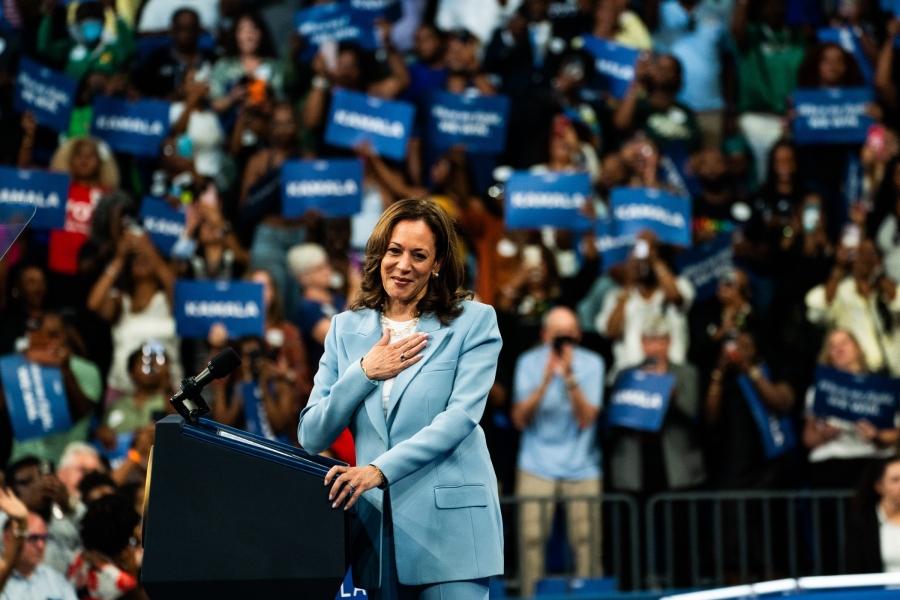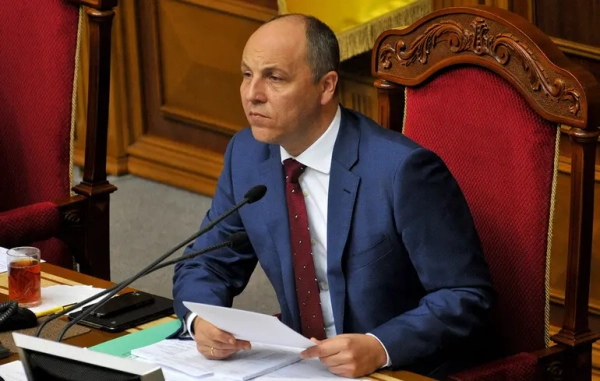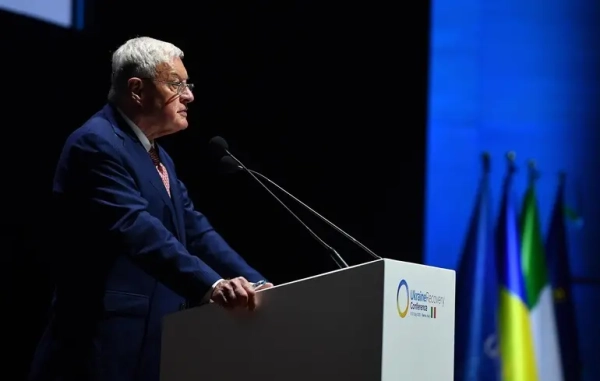
Eight years ago, when Hillary Clinton seemed poised to be elected the first female president of the United States, it sometimes seemed as though the candidate and the media couldn’t talk about it enough.
“I think it would be a great moment for our country,” Clinton told 60 Minutes about the possibility of becoming the first woman in the Oval Office. “Every little boy and every little girl should be given the chance to go as far as his or her hard work and talent might take them.”
On the trail, she underscored the possibility that she would end America’s long tradition of only electing men for president. “Clearly, I’m not asking people to vote for me simply because I’m a woman. I’m asking people to vote for me on the merits,” Clinton said at one event in 2015. “I think one of the merits is I am a woman, and I can bring those views and perspectives to the White House.”
Clinton leaned into the symbolism and meaning of her history-making run. She wore white — the color of the suffragist movement, which won the women’s right to vote in 1920 — as she accepted the Democratic nomination. She made a point of centering policy questions that had long been sidelined as women’s issues. And she framed her candidacy as the culmination of a generational project of women fighting for their political rights.
This year, the United States is once again on the verge of potentially making history with a woman at the top of the ticket, facing off against the same candidate from 2016. The observation that “history doesn’t repeat itself, but it often rhymes” feels prescient because the tidy comparisons end there.
This time, what was once a major election theme — whether America was ready to elect a woman as president, and what it would mean if it did — is mostly absent from the national conversation.
The changes have much to do with the different candidates and a very different set of circumstances this year. They also point to just how much the culture of politics in the US has transformed since 2016.
Harris’s campaign is approaching identity differently than Clinton’s did
As the nominee, Harris has made a point of sidestepping questions about her identity. When right-wing commentators launched misogynistic attacks on social media, amplified by former President Donald Trump, the campaign didn’t bother to respond. When Trump suggested, absurdly, to a gathering of the National Association of Black Journalists, that Harris had been hiding her identity as a Black woman and only recently “happened to turn Black,” Harris refused to take the bait.
“Same old tired playbook. Next question, please,” Harris laughed, when CNN’s Dana Bash asked her about Trump’s remarks in an interview.
Later in the interview, after Bash noted that Harris hadn’t mentioned her race or gender in her DNC acceptance speech, she asked about a viral photograph of Harris’s grandniece watching her accept the nomination from the audience. Harris again declined to talk about the potentially historic nature of her candidacy.
“I am running because I believe that I am the best person to do this job at this moment for all Americans, regardless of race and gender,” Harris said.
It’s a very different answer from the one Hillary Clinton gave 60 Minutes eight years ago. It was hard not to notice that, unlike Clinton, Harris wore a dark suit to accept the Democratic Party’s nomination, standing in front of a sea of delegates who wore white instead.
To be sure, Harris is finding ways to highlight the contrast between her and her opponent, such as forcefully advocating for reproductive rights against a candidate responsible for appointing Supreme Court justices who helped overturn Roe v. Wade and proposing to cap child care costs at 7 percent of a family’s income.
Harris has also spoken of being part of a new generation of leadership, which might be a more subtle way of highlighting her gender. “I think generational change is stylistically standing in for the conversation about electing a woman,” says Rebecca Traister, writer for New York magazine (which is part of Vox Media) and the author of multiple books about how women have reshaped contemporary politics. One of Trump’s most successful lines of attack against President Joe Biden was over his age; now he’s facing off against someone younger, non-white, and female — traits that have allowed Harris to make the case that she’s the change candidate, despite being the current vice president.
This campaign is different, but the culture of politics and media has changed dramatically since 2016 too
The decision not to emphasize the possibility that Harris would be the first Black woman president probably isn’t coincidental. Harris is likely running her campaign differently in an attempt to ensure a better outcome than 2016, when Clinton won the popular vote but still lost the election.
After her loss, an argument emerged, popular among the progressive and populist wings of the party, that Clinton and her supporters had overemphasized her gender as a selling point in the race, alienating voters who weren’t moved by the idea of making representational history. They argued that the party as a whole should do less talking about identity issues like race and gender, focusing instead on economic class and uniting people under a common set of Democratic ideals.
“One of the lessons coming out of 2016 is that focusing on identity was not enough to sway swing voters in battleground states,” says Jennifer Lawless, a professor of politics at the University of Virginia who studies the intersection of politics, media, and gender.
The question of whether Clinton talked too much about gender can’t be untangled from other thorny questions about her campaign and external factors like James Comey’s last-minute announcement that the FBI was investigating more of her emails.
But Harris is likely making the right choice in choosing not to emphasize gender. There’s good evidence to suggest that voters don’t want Harris to talk about gender or race, preferring instead that she focus on issues. The fact that Trump’s campaign is trying to drive the gender gap with overt appeals to male voters, says Lawless, means Harris can focus on issues that might matter to women without trying to win them by explicitly invoking identity.
“They’re making gender salient,” Lawless says of Trump and Vance. “Voters only need to look at Harris and realize she doesn’t hold those views. So she gets away from being ‘a woman running as a woman’ and still reaps the benefits.”
The choice to emphasize other messages during Harris’s short campaign is more than just thematic. It also speaks to the precarious place the campaign finds itself in, with only weeks left until Election Day.
This time, Democrats are much more aware of the fact that Harris might not win. The polls show a tighter race this year than they did in 2016, when the conventional wisdom, informed by inaccurate polls, was that Clinton was the favorite to win.
“I don’t think there’s a lot of excitement about talking about it for a bunch of PTSD-related reasons,” Traister says. “The last time it was a real possibility, we set the world on fire instead.” It’s not just that supporters are much more aware of the possibility that Harris might not win. It’s also that they’re more aware of what it will mean if Trump wins again.
Harris’s late entry into the race has also played a role in the conversation surrounding her campaign. In 2016, after Clinton emerged as the early frontrunner, she appeared on the cover of Newsweek, New York, Time, and the New Yorker, and was given frontrunner status and treated with extra scrutiny. Vogue made a first-time presidential endorsement in favor of Clinton and was one of the many magazines and news sites that devoted thousands of words to the question of whether she’d made history. (Full disclosure: I wrote one of those stories for Vox in 2016, but thankfully we waited to see if she won before running it.)
Clinton was also covered by a resurgent women’s media that invested in campaign coverage and championed causes like reproductive rights.
But women’s publications that had time to plan coverage for Clinton’s historic run were caught off guard, just like everyone else, by Harris’s late entry into the race, and the constellation of media outlets that reach voters have shifted. In 2016, Clinton wrote a piece for the Toast, a niche but much-loved feminist website, on its last day of publication; eight years later, the writers for the feminist blogosphere have largely moved on to more mainstream publications, and women’s publications aren’t as much of a fixture of campaign coverage. Harris did appear on the digital cover of Vogue this cycle, but she garnered more attention for appearing on newer outlets that have large female audiences, including the podcast Call Her Daddy.
Women in major political roles aren’t so rare anymore
Perhaps the biggest reason we don’t hear as much about whether the United States is ready to elect a woman is a simple one: The novelty may have worn off.
“There’s not as much of a question of whether America will elect a woman because they’ve done it all across the country, in all of the states,” says Christina Reynolds, who worked as Clinton’s deputy director of communications in 2016 and now serves as senior vice president for Emily’s List, an organization that works to elect Democratic women.
At this point, Harris isn’t the first woman nominee from a major party. Even if she won, she wouldn’t be the first woman to win the popular vote. If she succeeds in November, her supporters will of course celebrate the historic nature of her victory. But the fact that Harris has made it this far, when many Clinton supporters felt she was the only Democratic woman who had a shot of being elected in their lifetimes, is evidence of how many more women are serving in high-profile political positions post-2016.
“Eight years is not a lot of time in real life,” says Lawless. “But in politics, it’s forever.”
In 2018, a record number of women ran for office and won, sending more women to Congress than ever before. The ranks of highly visible women serving in political office expanded, too: Alexandria Ocasio-Cortez and The Squad became powerful leaders on the left, Stacey Abrams drew national attention by helping deliver Georgia to the Democrats, and in the 2020 Democratic primary, Harris ran for president alongside Sens. Elizabeth Warren, Amy Klobuchar, and Kirsten Gillibrand (former Rep. Tulsi Gabbard and Marianne Williamson ran, too).
Republican women also came to prominence in the years since 2016: Trump’s former press secretary, Sarah Huckabee Sanders, became governor of Arkansas, conspiracy theorist Marjorie Taylor Green is a household name, and Nikki Haley was the last candidate standing in the 2024 Republican primary against Trump.
As more women have run for office, political scientists have found that the gender biases long believed to be a barrier for women getting elected are less pronounced than previously believed. While Clinton was the target of sexism over her political career and other well-known female politicians face misogynistic attacks, those high-profile instances are not as predictive of the experience of women running for other offices as people may expect.
“For a long time, the notion was that underrepresentation is driven by demand-side effects, meaning voters don’t want female politicians because they think they can’t do a good enough job or that politics as a profession is very male-typed, and it runs against traditional gender notions of what women can and can’t do,” says Susanne Schwarz, an assistant professor of political science at Swarthmore College.
In a meta-analysis of 67 survey experiments asking voters to choose a hypothetical candidate, where gender was randomly assigned, Schwarz and a colleague found that women candidates actually performed a bit better than men. The finding echoes Lawless’s previous research showing that voters and the media, with some notable exceptions, generally treat women who run for office the same as men.
Harris entered late in the race, without a long campaign in which she could be tarnished by her opponents. She’s spent the last four years in a supporting role in the White House, visible but somewhat less scrutinized than her recent predecessors, including Joe Biden when he was serving as Barack Obama’s vice president. Those unique circumstances make her an unusual combination: well-known enough to have the obvious qualifications necessary to serve as president, but not well-known enough to have her reputation calcified, for better and for worse, in the minds of voters.
“Harris is much closer to the hypothetical candidate in these surveys” — the ones favored by voters — ”than Clinton was in 2016,” Schwarz says.
After 2016, Clinton’s candidacy and her loss sparked a lot of debate about what having better representation in politics can and can’t accomplish. “We’ve been forced to talk about gender, race, identity politics, and representational deficiencies in ways that had not been pressed in this country in the same way before,” Traister says. “There’s been quite a bit of smart conversations about representation and what it achieves and doesn’t. I think we’re a little smarter about representation and identity politics than we were before.”
Ultimately, Reynolds says, not having to talk about the history that Harris may or may not make in November is an encouraging development. If the candidate, media, and voters are talking about it less, it means that the question is probably less of a concern.
“I’m not saying we should never talk about gender,” Reynolds says. “But I think it’s nothing but positive that we don’t hear the question as much.”
Even if we don’t talk about it as much, other questions about gender, and particularly how it will impact each candidate’s vote totals, remain. Recent polls suggest an extremely close race, with Trump holding a double-digit lead with male voters and Harris holding a similar edge among female voters. Whether or not candidate gender is a major theme of the campaign, the gender divide driving more men to support Trump and more women to support Harris could be the defining factor in the race.
The question of whether the US would ever elect a woman president feels answered. The question of whether it will elect this woman this year? Not so much.
Source: vox.com






